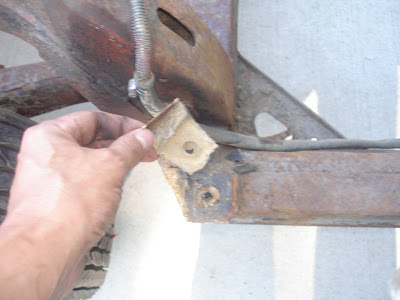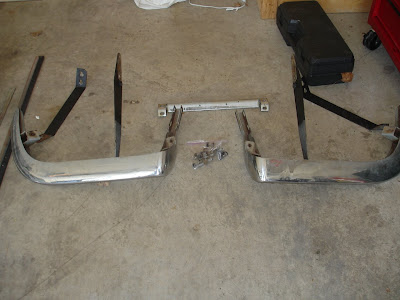 I chose a 1966 327/300 coupe. Ultimately, I like the thought of the small block. Given the hysteria that is attendant to the big blocks (and the silly prices paid) this car was a relative bargin. Also, I like the nature of the high winding small block. They have always been more enjoyable to drive (at least to me).
I chose a 1966 327/300 coupe. Ultimately, I like the thought of the small block. Given the hysteria that is attendant to the big blocks (and the silly prices paid) this car was a relative bargin. Also, I like the nature of the high winding small block. They have always been more enjoyable to drive (at least to me).
This particular car appears to have been off the road since 1978. From the general condition of the original vinyl interior and other areas I believe the 42,500 miles on the odometer to be orignial.
At some point in this cars past it appears to have sustained some fiberglass damage to the front end. In person I can easily see where new fenders have been cut in and bonded to the body. It makes me wonder what else I will find when I get the body off! More later on the restoration plan. For now I have included some addtional photos of what we have to work with.

While dirty, the interior is mostly original and shows no cuts or tears but needs much work.

The engine compartment shows the signs of a half hearted restoration. It will be completely disassembled and taken to original condition. I haven't determined whether I will rebuild it to 327/350 specs. I will have to consult with someone more knowledgeable on how that may impact the originality and value of the completed car.

6124449 F0520HE
The 327 engine in my Corvette reads 6124449 F0520HE. 6 is for the year (1966). Then the VIN sequence of 124449. The second part reads F for the Flint Plant, May 20 is the engine assembly date and the HE stands for a 327/300 hp with a manual transmission.
Since the vin sequence matches the VIN number on the car it is the original block that the left the factory 43 years ago. That is unless the block was decked and restamped. No one goes through the trouble to clone a 327/300 so I doubt that is the case here. With 427's or other big blocks the dollars that they were/are bringing makes the process of sorting the numbers more perilous and worth an expert opinion. There are likely more big blocks being traded than were ever produced by Chevrolet. Pathetic.

In the trim tag you will see
J17: Since this is a St Louis body (not A.O Smith) the J stands for June and 17 is the day. Therefore this vehicle was assembled on Friday, June 17, 1966.
66 437: 66 stands for 1966 and 437 denotes a coupe (467 is a convertible).
STD: the "STD" indicates that the car came with black vinyl.
S4429: S indicates that the body was constructed at the St Louis plant (A would mean it was an A.O. Smith body). 4429 means that is was the 4429th coupe body produced for the 1966 model year.
986AA: Indicates that the body was originally sprayed in pearl silver.

This is a bit mis-leading. In person, the paint is completely flat. It appears to have had a re-spray at some point. I will be sending this part of the restoration out. I want the paint to be stripped to the gelcoat and then returned to the original pearl silver.








 You can see in the pictures that the engine had undergone a cosmetic resto by the PO. This time it will be done correctly and completely. Still trying to decide whether it will be re-configured as a 327/350 vs. the 327/300 as it left the factory.
You can see in the pictures that the engine had undergone a cosmetic resto by the PO. This time it will be done correctly and completely. Still trying to decide whether it will be re-configured as a 327/350 vs. the 327/300 as it left the factory.









 6124449 F0520HE
6124449 F0520HE

